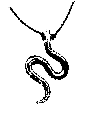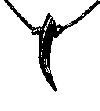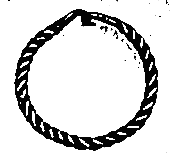

Symbols
Here is a short description of the historical background and meaning of the symbols I have used for forged jewelery. The information has been collected through various books, webpages and other sources. I will probably use runes also for decorations on other types of jewelery and on replicas of iron-age everyday items.
Symbols:
Runes: Click here!
 |
THE SPIRAL is an ancient symbol that basically represents the sun. It can be found in many cultures, the oldest being found engraved on a 24000 year old mammoth tooth made by Cro-Magnon hunters. This symbol was popular in Scandinavia during the Bronze age and Iron age/Viking era, symbolizing life force, energy and the seed of life. |
 |
THE SERPENT do have a reputation due to its role in Paradise, but other than that it is a very positive symbol. In North American Indian cultures, it represents fertility, rain, thunder and river. It can also be found in the Farmacy symbol (in Scandinavia), where the general meaning of healing is implied. It also represents the circle of life, wisdom and rebirth. The asian dragons are connected with the serpent symbol. |
 |
THE WOLF´S TOOTH represents the wolf, which stands for teacher, pathfinder and a forerunner for new ideas. The wolf has very strong family ties and sense of loyalty, but still great individualism. Among the stars, the wolf is represented by Sirius, which by many tribal people is considered to be the home of the Ancients, e.g. the home of the Gods. |
 |
THE SEID STICK was used by persons knowledgeable in seid, mostly women. It constituted a symbol for their status and position, and was also used for beating on the seid drum in order to reach a trance. A seid woman, called "völva", was of high statue while such a man was feared and avoided. While in a trance, the völva was in between worlds, and could then reach knowledge and insights otherwise concealed. During this journey of her soul, the völva sat on an elevated seat in the big hall, surrounded by people chanting to call upon the spirits. She could then provide information regarding the future, destinies and many other things. |
 |
THE SPEARHEAD or ARROWHEAD symbolises protection and awareness within native American indian cultures. As a Norse symbol it symbolises Othin, the allfather. He carried a spear named Gungner, which was forged by the dwarf Brokk. Othin was the god of the warriors, but can symbolwise also stand for destiny, wisdom and insight. |
 |
THE TROLL CROSS (free translation..) is, according to old Scandinavian folklore a powerful protection symbol efficient on both evil trolls and other similar beings that might be lurking in the woods. Iron and steel is feared by the trolls, and steel in a crosswise pattern is even more efficient. This pendant protects the bearer from evil, and this and similar symbolic designs has been widely used to protect both people, animals and buildings. |
 |
THE HAMMER OF THOR, Mjölner, is the symbol for Thor, the god of thunder and lightning who was the friend and protector of all humans. According to the legend, Mjölner was forged by dwarfs knowledgeable in magic. Mjölner was then brought to Asgård, the home of the gods, as a gift to Thor. The hammer symbol stands for protection against evil forces and as a fertility symbol. In certain parts of Sweden hammer symbols was put in the bed of newly wedded couples as protection and for fertility. This has been known to be done also in modern times. |
 |
THE OATH RING was used, and is still used, by people following the old ways of the Norse to enter into agreements, oaths, enter kindreds, at rituals and to enter into marriage. There are a number of ring findings, with rings made of gold, silver, bronze and iron. These rings are of both an open and a closed loop design, where the open ones have been worn around the neck. This would symbolize that the bearer was responsible for the well-being of his people, and if he failed them his neck would be in jeopardy. Ring findings are quite common both in Sweden and in the rest of Europe, dating back from around 2000 BC (Celtic) to the iron age/viking era. The ring to the left is around 8-9 inches in diameter, weighing almost two pounds. See more pics in the gallery. |
| HOME |